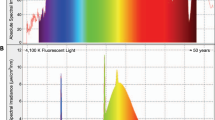Abstract
We measured ultraweak emissions of the Xenopus laevis eggs and embryos during normal development and under the influence of stress factors in a spectral range of 250 to 800 nm using a photomultiplier. The registered emissions were analyzed by several basic characteristics: mean intensity, histograms, kurtosis, linear trends, and Fourier spectra. We followed relationships between these parameters and developmental stage, as well as the number of individuals in optic contact with each other. The ultraweak emissions did not differ from the background at all developmental stages according to the mean intensity. But Fourier analysis revealed the reliable presence of a number of spectral lines of ultraweak emission, predominantly in the range of 10−2–50 Hz, in the embryos at developmental stages 2 to 11. The intensity of ultraweak emissions reliably decreased within the first 10 min after egg activation and fertilization, as well as in the case of optic interaction between groups of embryos. Sharp cooling, increase in osmotic medium pressure, and transfer in a Ca2+ and Mg2+-free medium induced a short term (∼1–5 min) increase in the mean intensity of ultraweak emission. We studied specific features of ultraweak emissions from different parts of the embryo. The intensity of emission from the animal part of early blastula exceeded those from the vegetal area and entire embryo. Separated fragments of the lateral ectoderm at the neurula stage had higher mean intensities of ultraweak emission than intact embryos at the same developmental stages.
Similar content being viewed by others
References
Beloussov, L.V., Burlakov, A.B., and Louchinskaia, N.N., Biophotonic Patterns of Optical Interactions between Fish Eggs and Embryos, Indian J. Exp. Biol., 2003, vol. 41, pp. 424–430.
Budagovskii, A.V., Distantsionnoe mezhkletochnoe vzaimodeistvie (Distant Cell Interaction), Moscow: NPLTs “Tekhnika”, 2004.
Burlakov, A.B., Burlakova, O.V., and Golichenkov, V.A., Distant Interactions of Loach Embryos of Different Ages, Dokl. Akad. Nauk, 1999, vol. 368, no. 4, pp. 562–564.
Galle, M., Population Density-Dependence of Biophoton Emission from Daphnia, Recent Advances in Biophoton Research and Its Applications, Popp, F.-A., et al., Eds., Singapore: World Scientific, 1992, pp. 345–356.
Grasso, F., Musumeci, F., Triglia, A., et al., Self-Irradiation Effect on Yeast Cells, J. Photochem. Photobiol., 1991, vol. 54, pp. 147–149.
Gurwitsch, A.G. and Gurwitsch, L.D., Mitogeneticheskoe izluchenie. Fiziko-khimicheskie osnovy i prilozheniya v biologii i meditsine (Mitogenetic Emission. Physicochemical Foundations and Applications in Biology and Medicine), Moscow: Medgiz, 1945.
Inaba, H., Ultraweak Biophoton Imaging and Information Characterization, Ultrafast and Ultra-Parallel Optoelectronics, Sueta, T. and Okoshi, T., Eds., Tokyo: Ohmsa/Jhon Wiley and Sons, 1995, pp. 570–580.
Mieg, C., Mei, W.P., and Popp, F.-A., Technical Notes to Biophoton Emission, Recent Advances in Biophoton Research and Its Applications, Popp, F.-A., et al., Eds, Singapore.: World Scientific, 1992, pp. 197–206.
Nieuwkoop, P.D. and Faber, J., Normal Table of Xenopus laevis (Daudin), Amsterdam: North Holland, 1956.
Niggli, H.J., Temperature Dependence of Ultraweak Photon Emission in Fibroblastic Differentiation after Irradiation with Artificial Sunlight, Indian J. Exp. Biol., 2003, vol. 41, pp. 419–423.
Nikolaev, Yu.A., Distant Interactions of Bacterial Cells, Mikrobiologiya, 1992, vol. 61, no. 6, pp. 1065–1071.
Popp, F.-A. and Klimek, W., Photon Sucking as an Essential Principle of Biological Regulation, Biophotonics and Coherent Systems in Biology, Beloussov, L.V., et al., Eds., 2006, pp. 17–32.
Scordino, A., Triglia, A., Musumeci, F., et al., Influence of the Presence of Atrazine in Water on in vivo Delayed Luminescence of Acetabularia acetabulum, J. Photochem. Photobiol. B, 1996, vol. 32, pp. 11–17.
Slawinski, J., Necrotic Photon Emission in Stress and Lethal Interactions, Curr. Topics Biophys., 1990, vol. 19, pp. 8–27.
Triglia, A., La Malfa, G., Musumeci, F., et al., Delayed Luminescence as an Indicator of Tomato Fruit Quality, J. Food Sci., 1998, vol. 63, pp. 512–515.
Van Wijk, R., Van Aken, H., Mei, W.P., and Popp, F.-A., Light-Induced Photon Emission by Mammalian Cells, J. Photochem. Photobiol. B, 1993, vol. 18, pp. 75–79.
Vogel, R. and Sussmuth, R., Weak Light Emission from Bacteria nd Their Interaction with Culture Media, Biophotons, Jiin-Ju Chang, et al., Eds., Dordrecht.: Kluwer Academic, 1998, pp. 19–46.
Author information
Authors and Affiliations
Corresponding author
Additional information
Original Russian Text © I.V. Volodyaev, L.V. Beloussov, 2007, published in Ontogenez, 2007, Vol. 38, No. 5, pp. 386–393.
Rights and permissions
About this article
Cite this article
Volodyaev, I.V., Beloussov, L.V. Ultraweak emissions of developing Xenopus laevis eggs and embryos. Russ J Dev Biol 38, 322–328 (2007). https://doi.org/10.1134/S1062360407050074
Received:
Accepted:
Issue Date:
DOI: https://doi.org/10.1134/S1062360407050074




